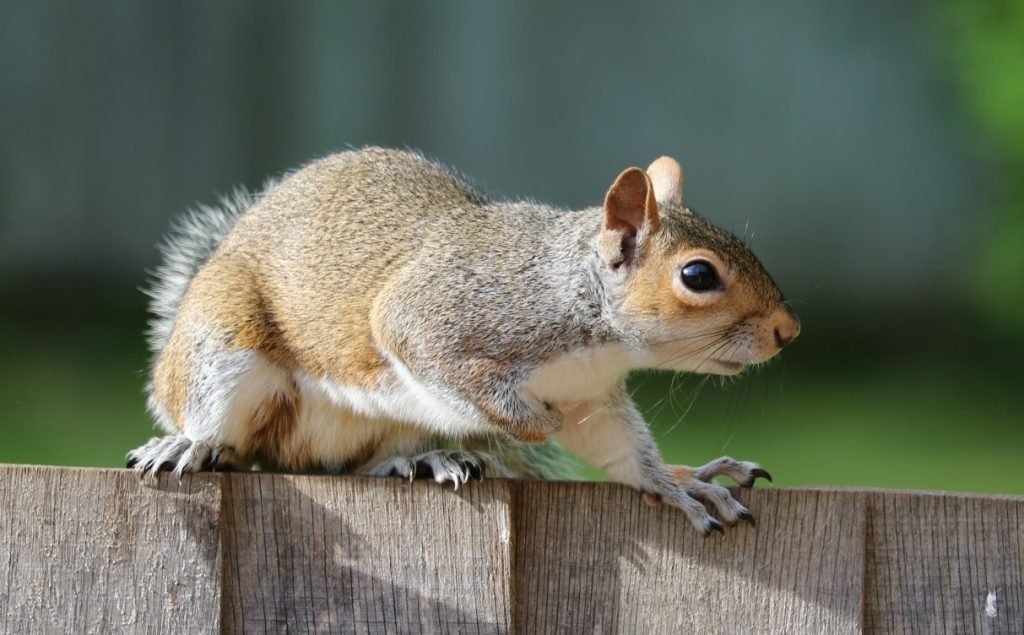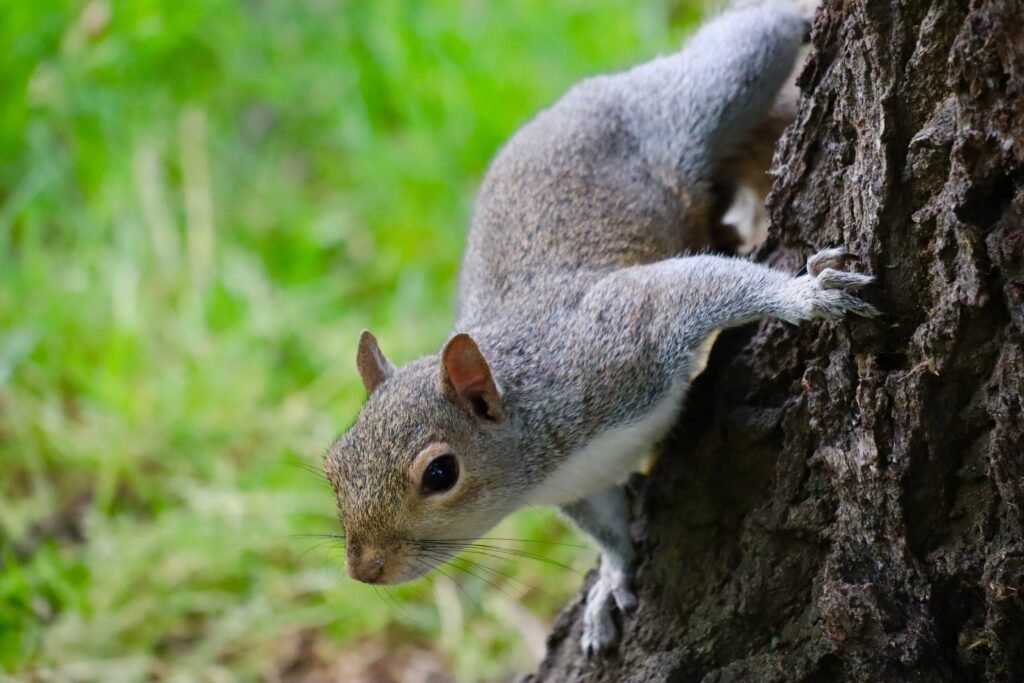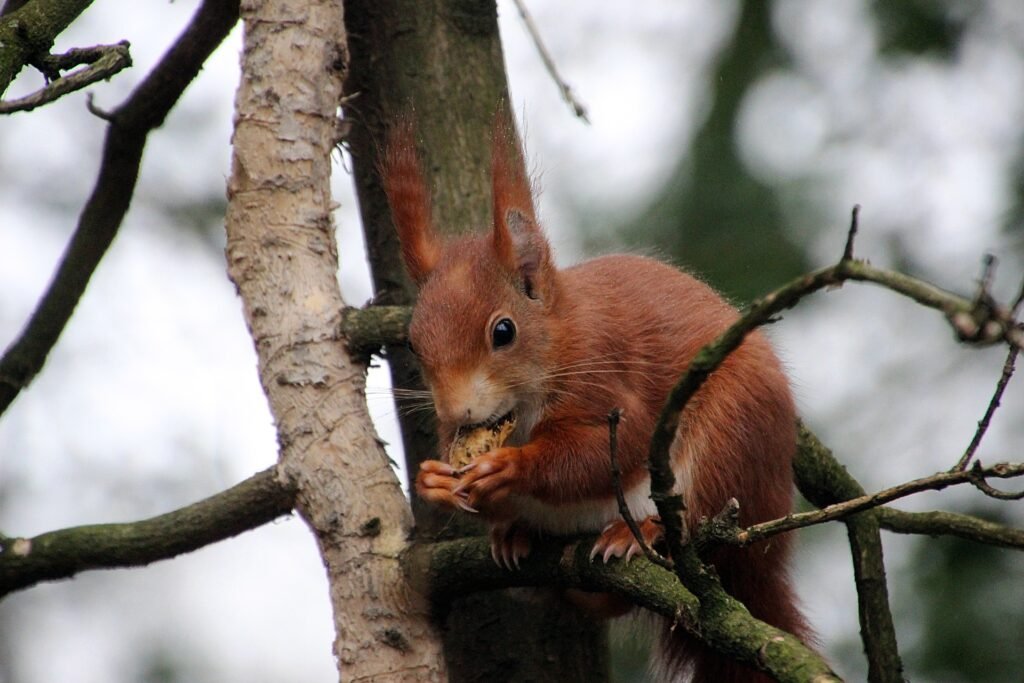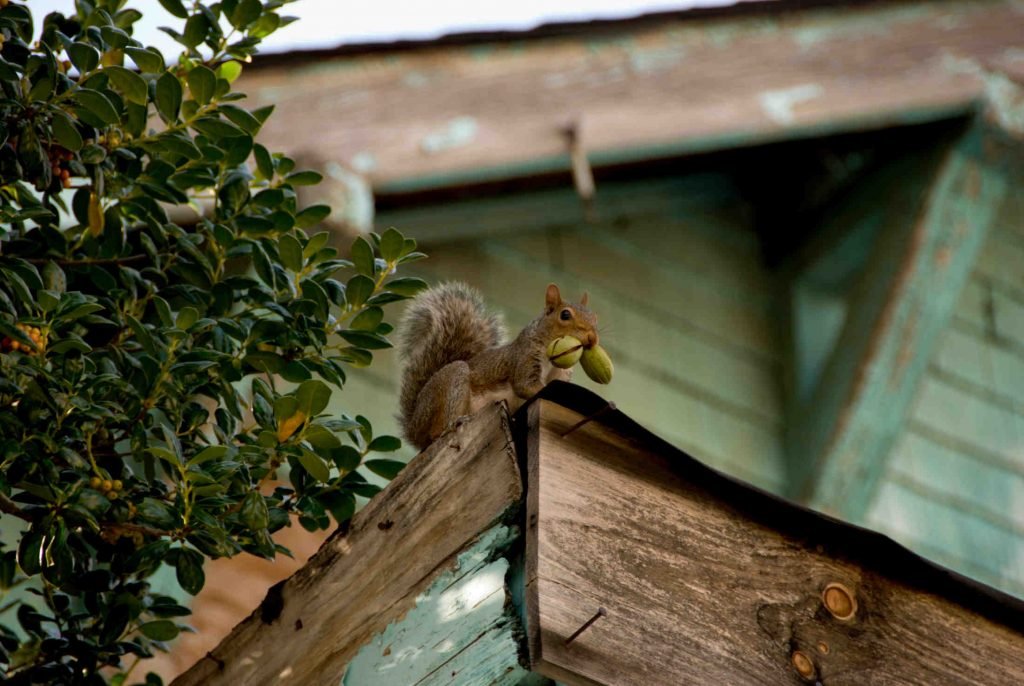Squirrel Trapping & Control

Squirrels in the attic are considered a nuisance and squirrel removal services should be performed before costly damage can occur. These rodents will seek out weak spots to gain access to a home’s attic and eaves. They gnaw at wood and push their way through the screens that cover roof vents. Squirrels can chew electrical wiring, making them a fire hazard once inside. Their urine and feces also soil attic insulation, which becomes compacted when the critters construct their nests. Insulation that squirrels have compromised is inefficient and could contain ectoparasites such as fleas.
If you have a squirrel in your attic, you should have it trapped and removed as soon as possible. Animals Happen is here to provide homeowners with the best local wildlife removal companies. If you believe squirrels have invaded your attic or another area of the home, contact us at 833-633-1120 to begin the squirrel removal process.
Identifying Squirrels
Squirrels are small rodents with long, slender bodies, bushy tails, and big eyes. Their fur is short, soft, and silky in general but varies in thickness depending on the squirrel species. Their fur comes in various colors, including whitish, gray, yellow, red, brown, and even black.
In the United States, both gray and red squirrels are common and plentiful. Gray squirrels can be found in almost all environments, and the red squirrel is commonly seen in the eastern half of North America. The gray squirrel is also known as the “eastern gray squirrel.” Red squirrels are also known as “pine squirrels” or “chickarees.” Along with flying squirrels, chipmunks, and woodchucks, they are all members of the squirrel family. Other squirrel species include the fox squirrel and the northern flying squirrel.1Go To Source mass.gov -“Learn About Squirrels”
Squirrel Life Expectancy
 A squirrel’s average life expectancy at birth is 1-2 years, while an adult’s average life span is closer to 6 years. Maximum life spans have been recorded in the wild at 12 years and in captivity at 20 years.
A squirrel’s average life expectancy at birth is 1-2 years, while an adult’s average life span is closer to 6 years. Maximum life spans have been recorded in the wild at 12 years and in captivity at 20 years.
Each year, female squirrels have two litters with an average of two to four young, but they can carry up to eight. Late winter and midsummer are the most common times for litters to be born. Squirrels wean themselves from their mothers after about two months, and they reach adulthood in nine months.
Squirrels are prolific breeders, so a small squirrel infestation can quickly grow into a large one. If you have a squirrel problem, contact squirrel control experts before the population gets out of hand. 2Go To Source esf.edu -“Gray Squirrel”
Predators Of Squirrels
Where Do Squirrels Construct Nests?
 Each species has different nesting habits, but the two most common locations are high up on tree branches and below ground in burrows. A female squirrel in need of a nest site may enter a home’s attic, chimney, or walls to construct her nest.
Each species has different nesting habits, but the two most common locations are high up on tree branches and below ground in burrows. A female squirrel in need of a nest site may enter a home’s attic, chimney, or walls to construct her nest.
Tree and flying squirrels will build nests in hollowed trees or abandoned woodpecker nesting sites. If none of these are available, they may build a nest in a nesting box or on the tree itself.
Chipmunks and other ground squirrel species, on the other hand, dig burrows in which to raise their young. During the winter, some of these species hibernate in these burrows. A burrow usually has at least one main entrance and exit hole, but depending on the species, there could be more. Ground squirrels and chipmunks can enter homes through basements, foundation cracks, and chimneys in urban areas.
Squirrel Diet
Squirrels of all kinds eat only plants. They are not picky eaters and will eat almost any food, but vegetables and fruit are their favorites. The squirrel’s favorite foods include corn, mushrooms, squash, and broccoli. Fruits such as apples, oranges, apricots, and avocados are also popular.
A squirrel’s diet also includes nuts. Acorns, walnuts, and peanuts are among this group’s favorite foods. In addition to nuts, they eat insects, seeds, eggs, and plant materials such as flower bulbs and roots. All rodents, including squirrels, have four front teeth that are constantly growing. They eat tree limbs, twigs, and bark to keep their teeth filed down.
Squirrels are hoarders who dig holes and stash their food in a variety of locations. They do this throughout the year, not just in the winter. Squirrels will destroy your garden in search of flower bulbs, which are a delicacy to them. Squirrels will also dig “fake” storage holes and leave no food inside, concealing their true food stashes from other animals.
Why Are Squirrels In The Attic Dangerous?
Many people do not consider squirrels to be a nuisance when they are outside. Are squirrels a more significant threat than they appear, aside from swinging from your birdfeeders and stealing from your garden? Yes, squirrels can wreak havoc both inside and outside your home. They also are rodents that harbor diseases that spread to humans. When you consider the physical damage and harmful bacteria associated with squirrels, they can be classified as one of the most harmful nuisance wildlife species.
Squirrel Damage
 Squirrels have evolved to the point where they can enter a home or business through the tiniest crack or hole. They’ll chew through roof shingles, house siding, and a variety of other materials if they can’t get in. Once inside a structure, squirrels will continue to chew through wood, insulation, and other building materials.
Squirrels have evolved to the point where they can enter a home or business through the tiniest crack or hole. They’ll chew through roof shingles, house siding, and a variety of other materials if they can’t get in. Once inside a structure, squirrels will continue to chew through wood, insulation, and other building materials.
A squirrel will quickly discover wiring and utility lines in the walls if it enters an attic. As they travel through the dark areas of the house, squirrels are looking for materials to build nests, strengthen their teeth, and eat. Chewing wiring is a common occurrence in buildings with squirrels and other rodents.
Diseases Spread By Squirrels
The feces of a squirrel can spread disease. Salmonella and leptospirosis are the most common diseases found in squirrel droppings. Typhoid fever, food poisoning, gastroenteritis, enteric fever, and other illnesses are all caused by Salmonella, while leptospirosis is a bacterial infection that causes vomiting, fever, aches, headaches, and stomach pains. Leptospirosis is frequently misdiagnosed as the flu.
Squirrels like to hide, so good luck finding one if it dies. Squirrels have been reported to perish in walls, under floors, vents, and crawl spaces. When you start smelling the dead squirrel, you’ve already done a lot of damage. Even after the body has been removed by professionals, it will continue to emit an odor that often necessitates professional cleaning.
Squirrel Control Services
Our pre-qualified wildlife control professionals will determine the most effective and humane way to remove the squirrels from your property when performing squirrel removal. Live trapping, one-way doors, deterrent, and direct capture are the most common methods used.
Adult squirrels are not directly captured because they move too quickly and fit into very small spaces. If a young squirrel is discovered in an attic, it will be removed by hand and relocated with its mother. If mom isn’t around and the babies aren’t old enough to survive independently, the wildlife experts will seek assistance from a nearby wildlife rehabilitation center.
Preventing Squirrel Infestations
The most effective way to keep squirrels and other wildlife out of your house is to use preventative exclusion. After the squirrel has been removed, it is critical to seal all entry points to prevent future entry. Squirrels, like other rodents, have constantly growing front teeth, allowing them to chew a new way back into your home.
Precautions such as removing trees branches on or near your roof can help prevent squirrels from entering or re-entering your home. Our pre-screen squirrel control experts can conduct a final walkthrough after squirrel removal to identify all weak points that need to be fortified. They can also perform all repairs and install devices such as vent covers to prevent future squirrel infestations.
Have Squirrels Found Their Way Into Your Attic?
You should contact us if you suspect squirrels in the attic, hear noises in the attic, or see squirrels crossing the roof.
Our pre-qualified wildlife technicians are experts at all things squirrel problems, including squirrel control, squirrel damage repair, squirrel removal, and squirrel trapping techniques. The squirrel control professionals can assess the situation, trap and remove the squirrels, and make the necessary repairs to seal any holes or construction gaps that may be allowing them access to your home. Give us a call at 833-633-1120 to begin removing nuisance squirrels today!
Sources:
- Commonwealth of Massachusetts. “Learn about Squirrels.” Mass.Gov, Commonwealth of Massachusetts, www.mass.gov/service-details/learn-about-squirrels. Accessed 19 July 2021.
- Communications, Esf Office Of. “Gray Squirrel | Adirondack Ecological Center | SUNY ESF | College of Environmental Science and Forestry.” Esf.Edu, State University of New York, www.esf.edu/aec/adks/mammals/gray_squirrel.htm. Accessed 19 July 2021.
- “Red & Gray Squirrels in Massachusetts”. MassWildlife. Massachusetts Division of Fisheries and Wildlife. Archived from the original on 17 May 2013
- Tree Squirrels, Wildlife Online, 23 November 2010.
- “squirrel, n.”. The Oxford English Dictionary (2nd. ed.). Oxford University Press. 1989. Retrieved 8 November 2010.
- “Squirrel”. Online Etymology Dictionary. Retrieved 7 February 2008.
